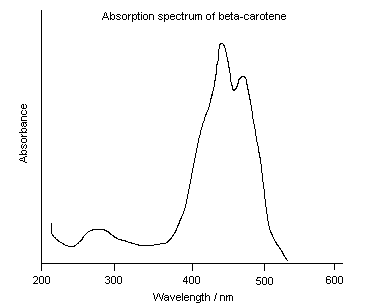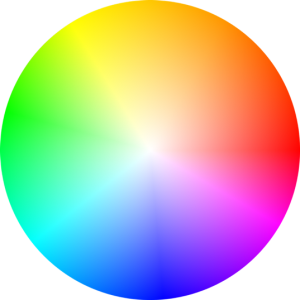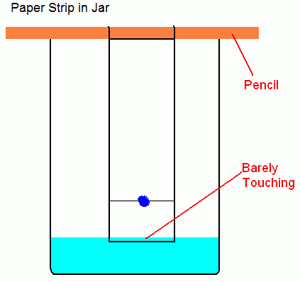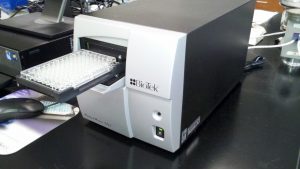by M. J. Simpson

Introduction
Colored chemicals absorb and sometimes emit light in the visible portion of the electromagnetic spectrum, which is 400 – 700 nm. Absorption occurs when an electron absorbs the energy from the light, temporarily promoting the electron to a higher energy orbital. Light emission can occur when the electron relaxes back to the ground state and produces light, but emission is less common than absorption because there are non-radiative ways for the electron to relax.


Unless a chemical is emitting light, the color that a chemical absorbs is the opposite of the color that it appears. The color wheel shows which colors are opposite. For example, -carotene, a pigment found in many fruits and vegetables including carrots, absorbs purple and blue light (400 – 500 nm), so it appears yellow/orange.
In today’s lab, you will investigate a variety of colored dyes. In the first part of the lab, you will use paper chromatography to determine the number of dyes present in your Kool-Aid packet. Then, you will measure the absorption spectrum of several food dyes and your Kool-Aid packet. This will allow you to identify the dye(s) present in your Kool-Aid packet. In the second part of the lab, you will use prepared dyes to alter the absorption properties of a cellulose t-shirt, which does not absorb visible light in its natural state.
Procedure
Paper chromatography experiment
 Prepare a dilute salt water solution using approximately 0.1 g of NaCl per 100 mL of DI water. Take a small amount of your Kool-Aid packet. Mix with a few drops of water to make a dark-colored slurry. A good concentration is about 15% wt. Kool aid powder in water. Using a wooden stick, make a dot of the mixture on a rectangular piece of filter paper about an inch from the bottom. Wait for it to dry. If it is not clearly visible, make another dot in the same spot. You can accelerate the drying process by blowing air on it. Suspend the paper in a beaker containing a small amount of salt water using the same wooden dowel. Allow the filter paper to just touch the top of the water (you don’t want the water to touch the spot of Kool aid). Leave the paper in the water until the dye(s) sufficiently separate or until you are sure there is only one dye present (wait at least 10 minutes).
Prepare a dilute salt water solution using approximately 0.1 g of NaCl per 100 mL of DI water. Take a small amount of your Kool-Aid packet. Mix with a few drops of water to make a dark-colored slurry. A good concentration is about 15% wt. Kool aid powder in water. Using a wooden stick, make a dot of the mixture on a rectangular piece of filter paper about an inch from the bottom. Wait for it to dry. If it is not clearly visible, make another dot in the same spot. You can accelerate the drying process by blowing air on it. Suspend the paper in a beaker containing a small amount of salt water using the same wooden dowel. Allow the filter paper to just touch the top of the water (you don’t want the water to touch the spot of Kool aid). Leave the paper in the water until the dye(s) sufficiently separate or until you are sure there is only one dye present (wait at least 10 minutes).
Measuring the absorption spectrum of dyes and Kool-Aid

Microplate reader
Mix up the Kool-Aid solution with DI water in a beaker according to the packet’s instructions. You will only need a small sample of the Kool-Aid, so you may want to scale the instructions on the packet to mix up a small portion of the Kool-Aid. Use a micropipette to put a 200 μL sample of each dye and of your Kool-Aid mixture in a microplate and measure the absorption spectra with the microplate reader. Be sure to also run a blank sample of pure water. Record the major peak(s) present in each spectrum in a table. If you have never used a micropipette before, read these instructions for use of a micropipette. If your Kool-Aid absorbance measures greater than 1 at any wavelength, dilute the solution and try again. Be sure to record in your notes how you diluted it. Note: “tropical punch” flavor must be diluted extra.
Report
Use this worksheet for collecting your data. For the lab report, you and your partner will be making a poster using either PowerPoint or Illustrator. Use photographs of your experiment and the graphs and tables you generated during the experiment to make a visually appealing and informative poster. It should include the following:
- A concise, descriptive title;
- A brief abstract summarizing the experiment and the results;
- A short introduction to the question you are answering;
- A summary of the procedure you used (including photographs);
- The results you found in the form of tables and graphs;
- A discussion of the results, which must answer the following questions:
- How many dyes are present in your Kool-Aid? How did you know?
- What dye(s) are present in your Kool-Aid? How do you know?
- How do your results compare to the ingredients listed on the packet? If your results disagree with the ingredients list, what may have caused the disagreement?
- What are some sources of uncertainty? How might you resolve them?
- What other experiments could you do to confirm your results?
- A conclusion summarizing your findings.
Use this website for help creating an effective poster. Turn in an electronic version of your poster on Canvas and also post a .pdf version on the shared folder. We will present them on a high resolution screen, but if you would like to print a full size version, there is a plotter in the library you can use.
